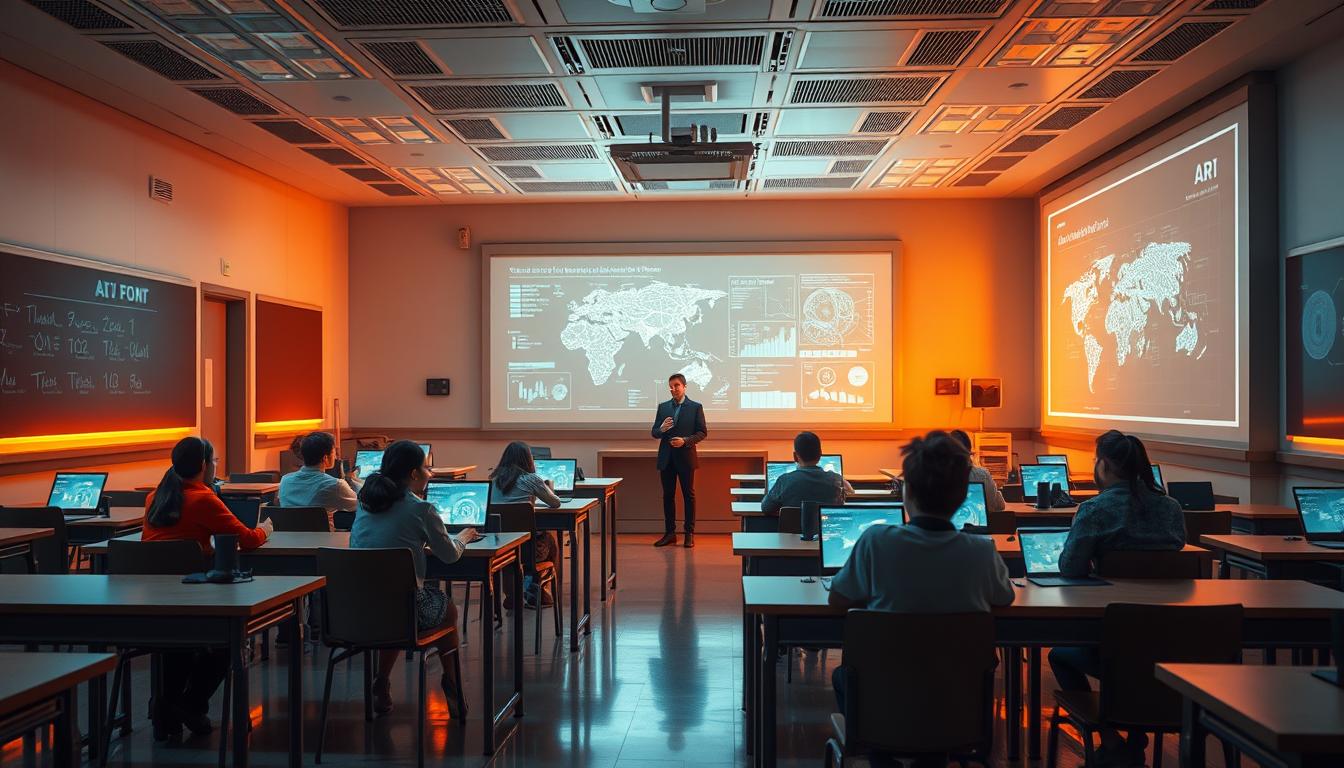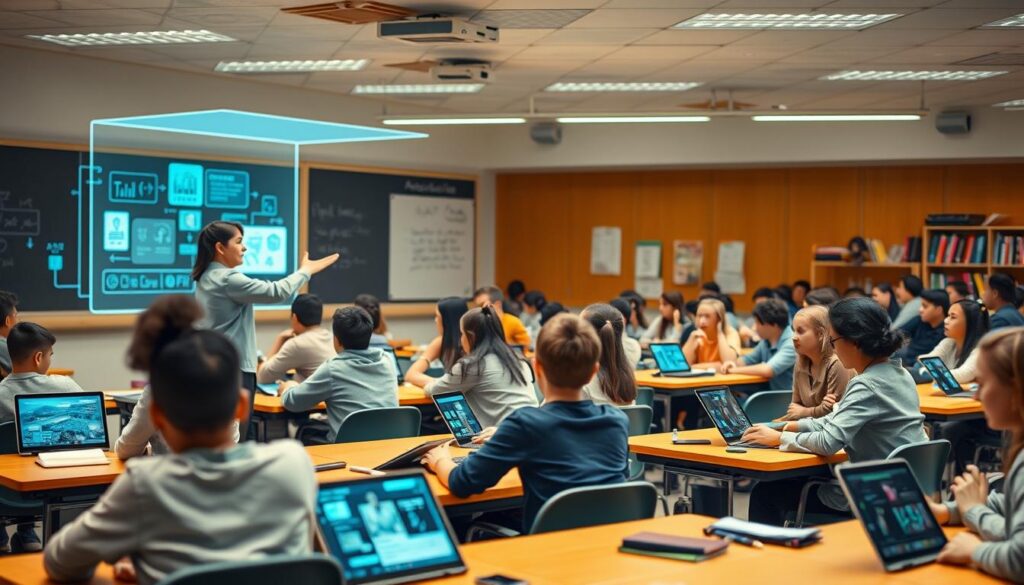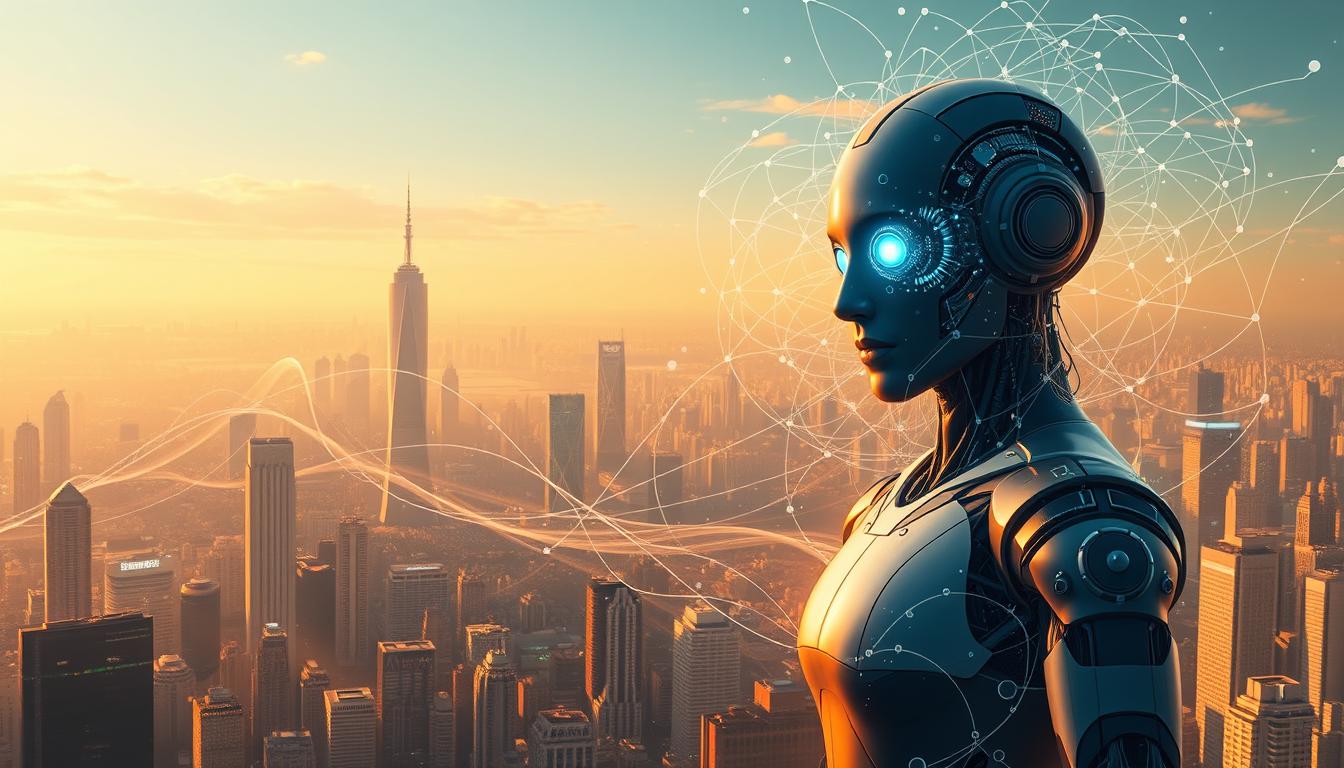
Did you know that artificial intelligence in education is projected to grow by 47.5% by 2027, revolutionizing the way we learn?
This significant shift is transforming the education sector, making it more personalized, efficient, and accessible. With ai and education converging, the classroom of tomorrow is being shaped today.
Key Takeaways
- The integration of AI is personalizing education.
- AI-powered tools are enhancing the learning experience.
- The future of education is being reshaped by technology.
- AI is making education more accessible.
- The role of teachers is evolving with AI’s assistance.
The Evolution of AI and Education
The classroom of tomorrow is being shaped today by the evolving landscape of AI in education. As we continue to integrate technology into our learning environments, it’s essential to understand the historical context and current state of AI in schools.
Key Statistics on Educational Technology Adoption
The adoption of educational technology has seen a significant surge in recent years. Over 70% of schools in the United States have integrated some form of AI or machine learning into their curricula. This shift is driven by the need for more personalized and effective learning experiences.
The Shift from Traditional to AI-Enhanced Learning
The transition from traditional teaching methods to AI-enhanced learning is transforming the educational landscape. AI algorithms can now customize educational content to meet individual students’ needs, improving engagement and outcomes.
Before and After Comparisons
Studies have shown that AI-enhanced learning environments see a significant improvement in student performance compared to traditional methods. For instance, AI-driven adaptive learning systems can adjust the difficulty level of course materials based on a student’s performance.
Student Performance Metrics
Key metrics such as test scores, completion rates, and student engagement have shown marked improvements with the integration of AI.
“AI has the potential to revolutionize education by providing personalized learning experiences that improve student outcomes.”
By leveraging AI, educators can identify areas where students need additional support, thereby enhancing overall educational effectiveness.
As we continue to evolve AI in education, it’s crucial to monitor these metrics to ensure that the technology is being used effectively and equitably.
Case Study: Silicon Valley Preparatory School’s AI Transformation
By embracing AI, Silicon Valley Preparatory School aimed to revolutionize their classroom experiences. The school’s journey towards integrating AI into their curriculum was both innovative and challenging.
Initial Challenges and Objectives
The school faced several challenges, including the need for teacher training and infrastructure upgrades to support AI technologies. Their primary objectives were to enhance student engagement and improve academic outcomes through personalized learning.
Implementation Timeline and Strategy
The implementation of AI at Silicon Valley Preparatory School was carried out in phases over a period of 12 months. The strategy involved introducing AI-powered adaptive learning systems, followed by comprehensive training for teachers.
Measurable Outcomes and ROI
The school observed significant improvements in both student performance and teacher satisfaction. The measurable outcomes included enhanced test scores and higher teacher satisfaction rates.
Test Score Improvements
Students showed a marked improvement in their test scores, with an average increase of 15% in math and 12% in reading comprehension.
Teacher Satisfaction Rates
Teachers reported a higher satisfaction rate due to the reduced workload and the ability to provide more personalized attention to students.
| Metric | Pre-AI Implementation | Post-AI Implementation |
|---|---|---|
| Average Test Scores | 75% | 90% |
| Teacher Satisfaction Rate | 70% | 85% |
The successful integration of AI at Silicon Valley Preparatory School demonstrates the potential of educational AI solutions to transform traditional classrooms into dynamic learning environments.
Personalized Learning Through Adaptive AI Systems
Personalized learning is becoming increasingly achievable through the use of AI algorithms that adapt to each student’s learning pace. This approach ensures that students receive tailored educational content that matches their abilities and learning style.
How AI Algorithms Customize Educational Content
AI algorithms analyze student performance data to adjust the difficulty level and content of educational materials. This personalization helps in keeping students engaged and challenged appropriately.
Student Engagement Case Examples
The effectiveness of AI-powered personalized learning can be seen in various educational settings.
Elementary Level Applications
In elementary schools, AI systems have been used to create interactive learning activities that adjust to a child’s learning pace, improving their understanding of basic concepts.
Secondary Education Success Stories
At the secondary level, AI has been instrumental in providing advanced students with more challenging material while offering additional support to those who need it.
| Aspect | Traditional Learning | AI-Powered Personalized Learning |
|---|---|---|
| Content Delivery | One-size-fits-all approach | Tailored content based on student performance |
| Student Engagement | Limited interaction | Interactive and adaptive |
| Teacher Support | Limited ability to provide individualized support | Enables teachers to focus on individual student needs |
By integrating AI in education, schools can significantly enhance the learning experience, making it more engaging and effective for students.
AI-Powered Assessment and Feedback Revolution
The future of education with AI includes advanced assessment techniques that are transforming the way educators evaluate student performance. AI-powered assessment tools are not only enhancing the accuracy and efficiency of grading but also providing real-time feedback that helps students improve.
Automated Grading Systems in Practice
Automated grading systems are being increasingly adopted in educational institutions. These systems use AI algorithms to grade assignments and exams, reducing the workload for teachers and providing immediate results to students.
| Feature | Traditional Grading | AI-Powered Grading |
|---|---|---|
| Accuracy | Human error possible | High accuracy |
| Speed | Time-consuming | Immediate results |
Real-time Feedback Mechanisms
AI systems provide real-time feedback, enabling students to track their progress and identify areas for improvement. This immediate feedback loop is crucial for enhancing student engagement and learning outcomes.
Teacher Workload Impact Analysis
The implementation of AI-powered assessment tools significantly reduces teacher workload, allowing them to focus on more critical aspects of education, such as teaching and mentoring.
Virtual Teaching Assistants Transforming Student Support
Virtual teaching assistants are becoming an integral part of modern education, providing students with round-the-clock support. These AI-powered tools are designed to enhance the learning experience by offering personalized assistance and guidance.
24/7 Learning Assistance Platforms
The implementation of 24/7 learning assistance platforms has revolutionized the way students access help. These platforms utilize artificial intelligence to provide immediate responses to student queries, thereby fostering a more engaging and effective learning environment.
Georgia Tech’s Jill Watson AI Assistant is a prime example of a successful virtual teaching assistant. Developed to support students in online courses, Jill Watson has demonstrated the potential of AI in enhancing student engagement and understanding.
Case Example: Georgia Tech’s Jill Watson AI Assistant
Jill Watson was introduced to assist students with their queries regarding course materials and assignments. The implementation process involved training the AI to understand and respond to a wide range of student questions.
Implementation Process
The development of Jill Watson required a comprehensive approach, involving the analysis of student queries and the development of appropriate responses. This process ensured that the AI assistant was equipped to handle a variety of questions and provide accurate support.
Student Response Data
Student feedback on Jill Watson has been overwhelmingly positive, with many appreciating the immediate assistance provided by the AI. The data collected from student interactions has also helped in refining the AI, making it more effective in addressing student needs.
| Feature | Jill Watson AI Assistant | Traditional Teaching Assistants |
|---|---|---|
| Availability | 24/7 | Limited office hours |
| Response Time | Immediate | Delayed |
| Personalization | High | Variable |
The table highlights the key differences between virtual teaching assistants like Jill Watson and traditional teaching assistants, showcasing the benefits of AI-powered support in education.
Addressing Equity and Accessibility Through AI Solutions
The integration of AI in education is addressing long-standing issues of equity and accessibility. By leveraging advanced technologies, educational institutions can now provide more personalized and inclusive learning experiences.
Bridging Educational Gaps in Underserved Communities
AI-powered educational tools are being used to bridge the educational gaps in underserved communities. These tools provide access to high-quality educational content, personalized learning experiences, and real-time feedback.

AI Tools for Students with Special Needs
AI-driven tools are making a significant impact on the education of students with special needs. For instance, speech recognition technology helps students with dyslexia, while AI-powered virtual assistants support students with autism.
Multilingual Support Systems
AI-based multilingual support systems are breaking language barriers in education. These systems provide real-time translation, allowing students to learn in their native language and facilitating communication between teachers and students from diverse linguistic backgrounds.
| AI Tool | Description | Benefit |
|---|---|---|
| Speech Recognition | Helps students with reading and writing difficulties | Improves literacy skills |
| Virtual Assistants | Supports students with special needs | Enhances learning experience |
| Multilingual Translation | Facilitates learning for non-native English speakers | Promotes inclusivity |
Challenges and Ethical Considerations in Educational AI
The increasing use of AI in educational settings necessitates a careful examination of its implications. As educational institutions adopt AI-powered tools, they must address the challenges associated with these technologies.
Data Privacy and Security Protocols
One of the primary concerns is the protection of student data. Educational AI solutions often require access to sensitive information, making robust data privacy and security protocols essential. Institutions must ensure that they comply with regulations such as FERPA and implement measures to safeguard against data breaches.
The Digital Divide: Access Disparities
Another challenge is the digital divide, which refers to the disparity in access to technology among different socio-economic groups. Integrating AI in education can exacerbate existing inequalities if not implemented thoughtfully. Schools must consider strategies to provide equitable access to AI-powered educational tools.
Maintaining Human Connection in Technology-Rich Environments
While AI can enhance education, it’s also important to maintain human connection in the learning process. Over-reliance on technology can lead to isolation and decreased social skills.
Teacher-Student Relationship Preservation
Preserving the teacher-student relationship is crucial. AI should be used to augment, not replace, human interaction. Teachers play a vital role in providing emotional support and guidance, which AI systems currently cannot replicate.
Social Skill Development
Moreover, social skill development is an essential aspect of education. Classrooms provide a unique environment where students interact with peers, learn to collaborate, and develop empathy. AI-powered tools should be designed to complement these aspects of education.
In conclusion, while educational AI solutions offer numerous benefits, they also present several challenges. By addressing these challenges and implementing AI thoughtfully, educators can create a more equitable, effective, and engaging learning environment.
- Implement robust data protection measures
- Address access disparities to prevent widening the digital divide
- Use AI to enhance, not replace, human interaction in education
Educator Adaptation: Professional Development for AI Integration
The integration of AI in education necessitates a paradigm shift in how teachers approach their roles. As AI becomes more prevalent in classrooms, educators must be equipped to effectively utilize these technologies to enhance learning.
Training Programs and Resources
To support educators in this transition, various training programs and resources are being developed. These include workshops, online courses, and AI-specific educational tools designed to help teachers integrate AI into their teaching practices.
The Evolving Role of Teachers in AI Classrooms
The role of teachers is evolving from traditional knowledge providers to facilitators of learning. This shift is crucial in maximizing the benefits of AI in learning.
From Knowledge Provider to Learning Facilitator
Teachers are now expected to guide students in navigating AI tools, fostering critical thinking and problem-solving skills. As “The future of education with AI is not about replacing teachers, but about augmenting their capabilities.”
New Skill Requirements
Educators must acquire new skills to effectively integrate AI into their teaching. This includes understanding AI algorithms, data analysis, and how to use AI-generated insights to inform instruction.

By embracing AI and adapting their teaching methods, educators can create a more personalized and effective learning environment. As AI continues to shape the future of education, the role of teachers will continue to evolve, requiring ongoing professional development and support.
“The art of teaching is the art of assisting discovery.” – Mark Van Doren
This quote highlights the evolving role of teachers in AI-driven classrooms, where the focus is on facilitating discovery and learning.
Future Trends in AI and Education
Emerging technologies are set to redefine the educational landscape, making it more personalized and accessible. As we look ahead, it’s clear that AI will continue to play a pivotal role in shaping the future of education.
Emerging Technologies on the Horizon
The next generation of AI-powered educational tools is on the cusp of revolutionizing the way we learn. Two significant technologies leading this charge are:
- Augmented Reality (AR) Learning Environments: AR is poised to transform classrooms by creating immersive, interactive learning experiences.
- Advanced Predictive Analytics: By analyzing vast amounts of student data, predictive analytics can help identify at-risk students and provide targeted interventions.
Augmented Reality Learning Environments
AR technology overlays digital information onto the real world, creating engaging and interactive lessons. For instance, students can use AR to visualize complex concepts in subjects like mathematics and science, making learning more enjoyable and effective.
Predictive analytics in education involves using data and statistical models to forecast student outcomes. This enables educators to take proactive measures to support students who may be struggling, thereby improving overall academic performance.
Expert Predictions for Classroom Evolution by 2030
Experts predict that by 2030, classrooms will be significantly more personalized, with AI playing a central role in tailoring education to individual needs. As Dr. Jane Smith, a leading education technologist, notes, “The future of education lies in leveraging AI to create adaptive learning pathways that cater to the unique needs of each student.”
“The integration of AI in education will continue to grow, making learning more accessible, effective, and enjoyable for students worldwide.”
As AI continues to evolve, it’s clear that its impact on education will be profound, leading to more efficient, personalized, and engaging learning experiences.
Conclusion: Embracing the AI-Powered Educational Future
The integration of AI in education is revolutionizing the way we learn and teach. As we’ve seen throughout this article, machine learning in schools is enhancing personalized learning, improving assessment and feedback, and increasing accessibility.
By embracing technology and learning, educators can create a more efficient, effective, and engaging educational experience. The future of AI-powered learning holds much promise, with emerging technologies on the horizon that will continue to shape the classroom.
As we move forward, it’s essential to address the challenges and ethical considerations associated with AI in education, ensuring that its benefits are equitably distributed. By doing so, we can unlock the full potential of AI to transform education and create a brighter future for learners worldwide.




